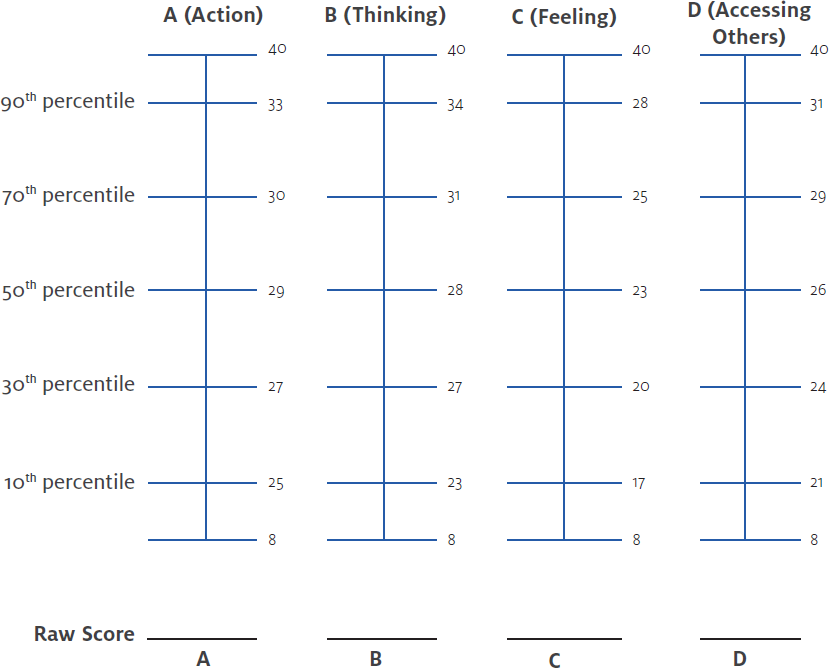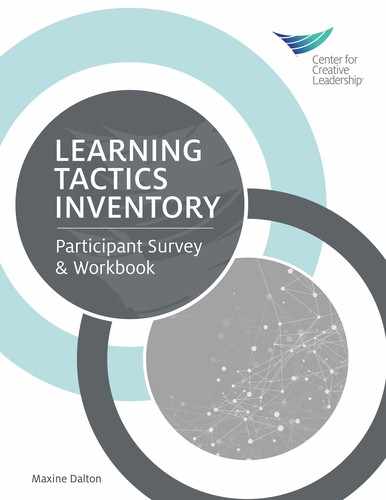Directions: To interpret your results, graph the totals from the four columns, A, B, C, and D, from the scoring sheet onto the charts below. If your exact score is not shown, simply mark your score in the approximate percentile block.

Look for scores that fall below the 50th percentile. These reflect tactics that you use less frequently than does half of the population in the database. Return to your questionnaire and identify all of the statements on which you gave yourself 1’s or 2’s. Record those tactics in the space below.
Tactics rarely used:
Reflect on how your failure to use these tactics has influenced your ability or willingness to learn from experience. Consciously try to use these tactics as you work to become a more versatile learner. Note that because these learning behaviors are influenced by your personality and how you think about things, trying them out will feel awkward and uncomfortable at first, like changing your golf stroke or your tennis grip. If you persist and practice, there can be a payoff in terms of new talents and skills.
Also note the tactics that you use most often, questions that you scored as 4 or 5.
Tactics used most often:
How has this way of learning helped you? Do you misuse or overuse these tactics? What has been the result?
A General Pattern of Low Scores
If you find that your scores fall below the 50th percentile on all four bar graphs, there are several possible explanations.
1. Some people have never spent any time thinking about how they learn. For that reason they find this exercise difficult and so use low or mid-range responses when answering the questions. If this seems to explain your scores, you may want to think some more about how you learn and then go back and answer the questions again.
2. Some people are very conservative raters. Whatever the question, they usually answer with 2’s, 3’s, and 4’s and rarely use 1’s or 5’s. If this is your pattern, look at your scores in terms of relative highs and lows. What are the highest rated items and lowest rated items for you? Use this information to think about how you learn and how to improve your ability to learn from experience.
3. Finally, low scores on all four of the tactics may mean that our list does not include how you learn. If that is the case, you need to create a learning history for yourself. Think through the challenging experiences you have had in your adult life, times when you have been successful in learning from
4. challenges and times when you have been unsuccessful. Write your thoughts in the space below. Look for the patterns. Use your learning history to determine whether you overuse or misuse one set of tactics at the expense of others.
Notes on my learning history:
Your scores on the Learning Tactics Inventory should become part of a personal development plan, which should provide you with a clear picture of what you want to learn, where you can learn it, and how you intend to go about it. A development plan for you to fill out is on pages 15 and 16, but first study the sample development plan below.
Sample Development Plan
What is your developmental goal? Identify a skill that you need in order to meet your career objectives and accomplish the work of the organization. This skill might be something that will help you be more proficient in your current job or it may be a skill that will help prepare you for a new job.
My goal is to learn how to influence without authority. This means becoming a better listener. It also means learning to understand an issue from others’ points of view. It means learning to solve problems so that everyone feels that his or her point of view has been taken into consideration and so that everyone gets something out of the solution.
Where can you start to practice this skill as part of your current job? Remember, development is not something that happens after you finish your work. Development is part and parcel of the work that you are doing.
We are a matrix-based organization and I cannot meet my own objectives for new product development without the committed support of the marketing group and the computer services group. I can start trying to practice all of these skills in the new product development work group.
Using your results on the Learning Tactics Inventory, identify how you can learn this new skill.
My learning preferences are in the Thinking column. I prefer to gather all the data, think through the problem, lay out my time line and get to work—on my own. My independent style really irritates the other people on the new product development team. I almost never ask for advice from others, solicit feedback on how things are going, or worry about how others might feel about what I am doing. I just want to get the work done! This is not working. It is slowing the process down. The more I try to ignore the members of the group—trying to keep things on schedule—the more we fall behind. As part of learning how to influence without authority, I am going to use some tactics from the Accessing Others column and some from the Feeling column. I will ask some people who have a successful track record of new product development to give me some tips on how to work with computer services and marketing. I am also going to start to ask members of the new product development work group for feedback on my style. In fact, I am going to tell them that I am trying to become a better listener and get better at seeing things from their points of view—and I am going to ask them from time to time to let me know how I am doing. Because it is part of my preferred style, I may also take a course on active listening.
